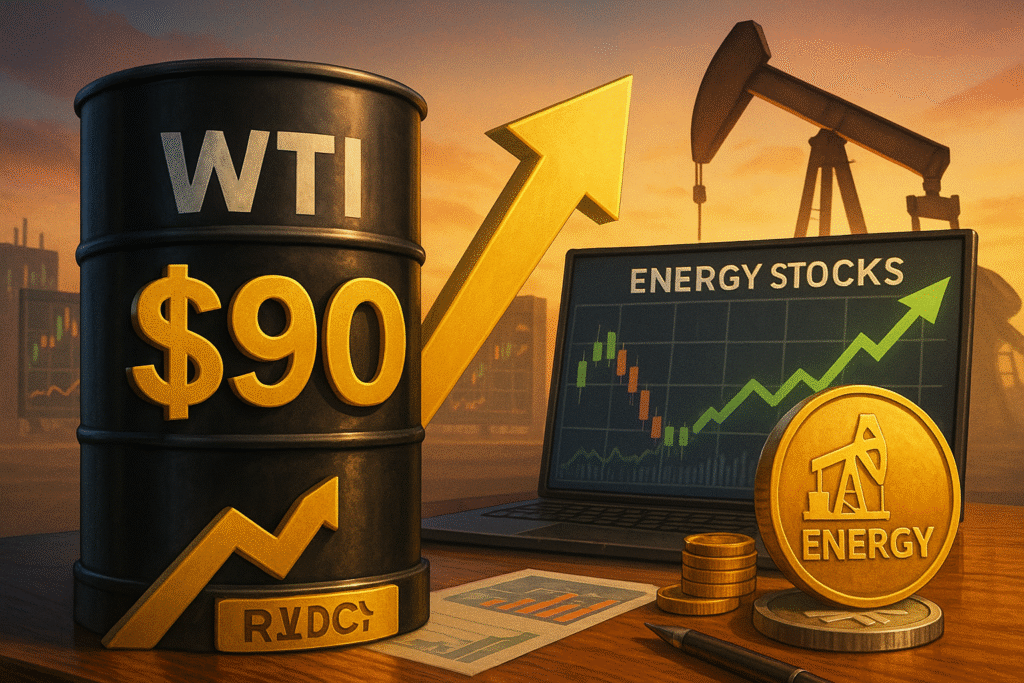WTI crude pushed above ninety dollars per barrel after OPEC+ agreed to extend supply cuts through early 2026. The move sparked a swift rally in the S&P Oil & Gas Select Industry Index, even though U.S. shale output is cooling. Traders now debate how long the oil price surge can last and what it means for drillers, refiners, and pipeline firms.

OPEC+ Extension Drives the Market
On Friday, the cartel confirmed a voluntary cut of 1.3 million barrels per day into next year. Saudi Arabia and Russia will shoulder most of the pullback. The news hit screens before the U.S. open, and crude futures jumped three dollars within minutes due to the ongoing surge in oil prices. Spot prices closed at a five-month high. The decision surprised some analysts who expected only a six-month extension.
Index Reaction and Sector Winners
The S&P Oil & Gas Select Industry Index rose nearly four percent on the day. Exploration and production names led the pack. Pioneer Natural Resources, Diamondback Energy, and Devon Energy each gained more than five percent amid increased profits fueled by the oil price surge. Midstream stocks lagged but still closed up one percent as pipeline tariffs adjust more slowly. The rally added to a year-to-date gain of ten percent for the index, outpacing the broader S&P 500 by seven points.
Shale Output Slows Despite the Oil Price Surge
U.S. shale production has inched lower since February. Fewer rigs and service crews are at work as drillers hold capital spending flat. The Energy Information Administration projects domestic output of 13.1 million barrels per day for July, down 200,000 barrels from March. Companies cite higher labor costs, limited fresh acreage, and investor demands for free-cash flow over volume growth. Despite these issues, the surge in oil prices creates a favorable price floor.
Fund Flows and Investor Sentiment
Energy-focused exchange-traded funds captured $1.1 billion in net inflows during the past two weeks. Options traders bought upside calls on oil majors and sold downside puts, signaling bullish sentiment. At the same time, money left utility and real estate funds, showing a rotation toward inflation-linked assets. The recent oil price surge has driven many managers to see energy as a hedge against sticky consumer prices and geopolitical shocks.
Risks That Could Reverse Gains
Several challenges could cool the rally. First, a sharp rise in U.S. interest rates might damp demand and strengthen the dollar, pressuring crude. Second, peace talks in key conflict zones could prompt OPEC+ to ease cuts sooner than markets expect. Third, a jump in non-OPEC supply from Brazil, Guyana, and Canada may offset Saudi discipline. If the current oil price surge dissipates, investors should track rig counts, inventory data, and policy headlines for early clues.
Outlook for Energy Equities
Most analysts raised 2025 earnings estimates by five to eight percent after the OPEC+ news. Forward price-to-cash-flow ratios remain below their five-year averages. Dividends and buybacks continue to draw income seekers. If oil holds above eighty dollars, the index could post mid-teens returns this year. Still, because volatility will follow each policy shift, the impact of an oil price surge can be significant. Active positioning and risk controls remain essential.
Oil markets appear tight, and the oil price surge has given energy stocks fresh momentum. Whether that momentum persists depends on disciplined supply cuts, resilient demand, and limited production growth outside the cartel. Investors should stay alert but may find renewed value in the sector.